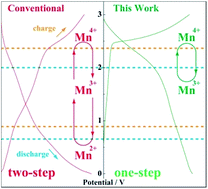当前位置:
X-MOL 学术
›
J. Mater. Chem. A
›
论文详情
Our official English website, www.x-mol.net, welcomes your feedback! (Note: you will need to create a separate account there.)
Kinetically controlled redox behaviors of K0.3MnO2 electrodes for high performance sodium-ion batteries†
Journal of Materials Chemistry A ( IF 11.9 ) Pub Date : 2018-05-11 00:00:00 , DOI: 10.1039/c8ta03543a Jiasheng Qian 1, 2, 3 , Ying San Chui 1, 2, 3 , Guijun Li 1, 2, 3 , Mei Lin 1, 2, 3 , Chi Man Luk 1, 2, 3 , Chun Hin Mak 1, 2, 3 , Biao Zhang 1, 2, 3 , Feng Yan 1, 2, 3 , Shu Ping Lau 1, 2, 3
Journal of Materials Chemistry A ( IF 11.9 ) Pub Date : 2018-05-11 00:00:00 , DOI: 10.1039/c8ta03543a Jiasheng Qian 1, 2, 3 , Ying San Chui 1, 2, 3 , Guijun Li 1, 2, 3 , Mei Lin 1, 2, 3 , Chi Man Luk 1, 2, 3 , Chun Hin Mak 1, 2, 3 , Biao Zhang 1, 2, 3 , Feng Yan 1, 2, 3 , Shu Ping Lau 1, 2, 3
Affiliation

|
Due to its abundance, high theoretical capacity, and environmental compatibility, manganese dioxide (MnO2) is regarded as a potential electrode material for sodium-ion batteries. Nevertheless, severe side reactions including manganese dissolution and the Mn3+ disproportionation reaction are common challenges to manganese-based electrodes that cause a huge capacity fading, further limiting their practical applications. To address these issues, here the environmentally friendly K-birnessite MnO2 (K0.3MnO2) nanosheets are directly inkjet-printed on the stainless steel sheet to serve as the electrode, while a diglyme-based electrolyte is used to fabricate a sodium-ion battery. In contrast to the conventional two-step redox reactions involving Mn4+/Mn3+/Mn2+ couples, the as-printed K0.3MnO2 electrode shows an enhanced redox activity of the Mn4+/Mn3+ couple, along with a suppressed redox activity of the Mn3+/Mn2+ couple that restricts the side reactions. The active particle size, electrode structure and electrolyte conditions could be identified as the key factors that contribute to the performance optimization. The electrode simultaneously and unprecedentedly achieves a working voltage of 2.5 V, maximum energy and power densities of 587 W h kgcathode−1 and 75 kW kgcathode−1, respectively, with 99.5% capacity retention for 500 cycles at 1 A g−1.
中文翻译:

高性能钠离子电池 K 0.3 MnO 2电极的动力学控制氧化还原行为†
由于其丰富,高理论容量和环境相容性,二氧化锰(MnO 2)被认为是钠离子电池的潜在电极材料。然而,包括锰溶解和Mn 3+歧化反应在内的严重副反应是锰基电极常见的挑战,它会引起巨大的容量衰减,从而进一步限制了它们的实际应用。为了解决这些问题,此处采用了环保型K水钠锰矿MnO 2(K 0.3 MnO 2纳米片直接喷墨印刷在不锈钢片上作为电极,而基于二甘醇二甲醚的电解质则用于制造钠离子电池。与涉及Mn 4+ / Mn 3+ / Mn 2+对的常规两步氧化还原反应相反,印刷的K 0.3 MnO 2电极显示出Mn 4+ / Mn 3+对的氧化还原活性增强。具有抑制的Mn 3+ / Mn 2+的氧化还原活性限制了副反应的夫妇。活性粒径,电极结构和电解质条件可以确定为有助于性能优化的关键因素。电极可同时前所未有地达到2.5 V的工作电压,最大能量和功率密度分别为587 W h kg阴极-1和75 kW kg阴极-1,在1 A g -1下500次循环的容量保持率为99.5%。。
更新日期:2018-05-11
中文翻译:

高性能钠离子电池 K 0.3 MnO 2电极的动力学控制氧化还原行为†
由于其丰富,高理论容量和环境相容性,二氧化锰(MnO 2)被认为是钠离子电池的潜在电极材料。然而,包括锰溶解和Mn 3+歧化反应在内的严重副反应是锰基电极常见的挑战,它会引起巨大的容量衰减,从而进一步限制了它们的实际应用。为了解决这些问题,此处采用了环保型K水钠锰矿MnO 2(K 0.3 MnO 2纳米片直接喷墨印刷在不锈钢片上作为电极,而基于二甘醇二甲醚的电解质则用于制造钠离子电池。与涉及Mn 4+ / Mn 3+ / Mn 2+对的常规两步氧化还原反应相反,印刷的K 0.3 MnO 2电极显示出Mn 4+ / Mn 3+对的氧化还原活性增强。具有抑制的Mn 3+ / Mn 2+的氧化还原活性限制了副反应的夫妇。活性粒径,电极结构和电解质条件可以确定为有助于性能优化的关键因素。电极可同时前所未有地达到2.5 V的工作电压,最大能量和功率密度分别为587 W h kg阴极-1和75 kW kg阴极-1,在1 A g -1下500次循环的容量保持率为99.5%。。

























 京公网安备 11010802027423号
京公网安备 11010802027423号